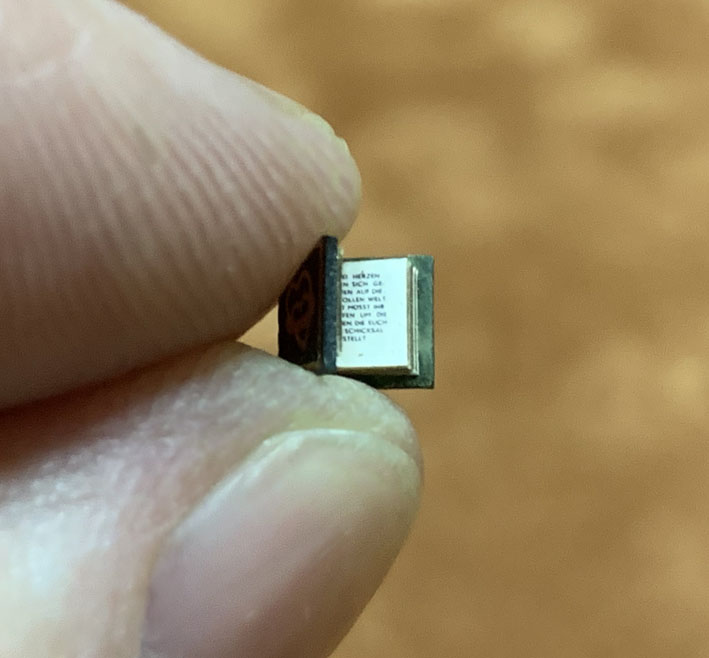What Is The Smallest Book In History?
Have you ever wondered what the smallest book in history is? Well, get ready for a fascinating journey into the world of miniature literature! From tiny tales that can fit in the palm of your hand to micro masterpieces that require a magnifying glass to read, the world’s smallest books have captured the imagination of book lovers and collectors alike. In this article, we’ll uncover the secrets behind the tiniest books ever created and explore the incredible craftsmanship that goes into making these miniature marvels.
Imagine holding a book so small that you need a microscope just to read the text. It may sound like something out of a fairy tale, but these miniature books are real. They may be small in size, but they pack a punch when it comes to creativity and craftsmanship. From the intricate illustrations to the meticulously crafted bindings, every detail of these tiny tomes is a testament to the skill and dedication of the artists and bookmakers who create them. Whether you’re a book enthusiast or simply intrigued by the wonders of the world, join us as we embark on a quest to discover the smallest book in history and uncover the hidden treasures of the literary world. Get ready to be amazed!
The smallest book in history is “Teeny Ted from Turnip Town.” Created by Robert Chaplin, this miniature book measures just 0.03 square inches and contains a full story with illustrations. It was recognized by Guinness World Records in 2007 as the smallest reproduction of a printed book. Despite its tiny size, it showcases incredible craftsmanship and attention to detail.

What is the Smallest Book in History?
The world of books is vast and diverse, encompassing works of various genres, sizes, and lengths. While we often associate books with lengthy novels or encyclopedic tomes, there are also miniature books that capture our fascination. These tiny literary treasures are marvels of craftsmanship and ingenuity, challenging our perception of what a book can be. In this article, we will explore the world’s smallest book and delve into its intriguing history.
The Origins of Miniature Books
Miniature books have a long and storied history that dates back centuries. The art of creating these diminutive literary works can be traced to ancient civilizations such as the Egyptians and Romans, who inscribed texts on small tablets or scrolls. However, it was during the medieval period that miniature books truly began to flourish. Monks crafted intricate manuscripts on a miniature scale, often using magnifying glasses to aid in the delicate process. These tiny books were highly prized possessions, treasured for their beauty and portability.
As printing technology advanced in the 15th century, miniature books became more accessible to the general public. The advent of the printing press allowed for the mass production of books, including those in miniature form. These tiny volumes gained popularity as curiosities and collectibles, showcasing the remarkable craftsmanship of bookbinders and printers.
The Smallest Book Ever Published
In the realm of miniature books, one title stands out as the smallest ever published: “Teeny Ted from Turnip Town.” This micro-book was created by Canadian author Malcolm Douglas Chaplin and printed by Robert Chaplin of Frogmore Paper Mill in the United Kingdom. Measuring a mere 0.07 square millimeters, “Teeny Ted from Turnip Town” holds the Guinness World Record for the smallest reproduction of a printed book.
Despite its minuscule size, “Teeny Ted from Turnip Town” contains a complete story with illustrations. The book follows the adventures of Teeny Ted, a turnip farmer who embarks on a quest to save his town from a terrible drought. The text is printed using a specialized electron beam lithography system, which allows for incredibly precise and detailed reproduction.
Creating such a tiny book is no small feat. The process involves intricate precision and meticulous attention to detail. Each page is carefully crafted and bound, with the text and illustrations etched onto the microscopic surface. The result is a remarkable work of art that pushes the boundaries of what we consider a book to be.
The Significance of Miniature Books
Miniature books hold a unique place in the literary world. They serve as tangible reminders of the beauty and craftsmanship that goes into bookmaking. These tiny treasures invite us to appreciate the artistry of the written word and the skill required to create such intricate works.
Moreover, miniature books offer a glimpse into the past, allowing us to explore the history and culture of different eras. They provide a window into the world of bookbinding, printing, and illustration techniques that have evolved over time. By examining miniature books, we can gain a deeper understanding of the evolution of the written word and the enduring appeal of physical books in an increasingly digital age.
In conclusion, the world’s smallest book, “Teeny Ted from Turnip Town,” showcases the ingenuity and artistry of miniature books. While it may be small in size, it leaves a big impression on those who encounter it. Through its intricate details and captivating story, this tiny book reminds us of the limitless possibilities of the written word and the enduring power of books in all their forms. So, next time you pick up a book, consider the vast range of sizes and the incredible craftsmanship that goes into creating these literary wonders.
Key Takeaways: What is the smallest book in history?
- The smallest book in history is called “Teeny Ted from Turnip Town.”
- It measures only 70 micrometers by 100 micrometers.
- The book was created using nanolithography, a process that involves etching tiny letters onto a silicon wafer.
- Despite its size, the book contains a complete story with illustrations.
- Teeny Ted from Turnip Town was written by Malcolm Douglas Chaplin and published in 2007.
Frequently Asked Questions
What is the history behind the smallest book ever created?
The history of the smallest book ever created is quite fascinating. The book, titled “Teeny Ted from Turnip Town,” was written by Malcolm Douglas Chaplin and published in 2007. It measures an astonishing 70 by 100 micrometers, making it the tiniest book in the world. The book contains a full story with a beginning, middle, and end, complete with illustrations. It was created using advanced nanotechnology techniques and can only be read with the aid of a microscope.
Despite its size, “Teeny Ted from Turnip Town” made a big splash in the literary world. It was recognized by the Guinness World Records as the smallest reproduction of a printed book. The creation of such a minuscule book required incredible precision and attention to detail, showcasing the ingenuity and creativity of its creator.
How was the smallest book in history created?
Creating the smallest book in history was a remarkable feat of engineering and craftsmanship. The process involved using advanced nanotechnology techniques to fabricate the tiny book. The text and illustrations were printed onto individual pages using specialized tools capable of extreme precision.
After the pages were printed, they were carefully bound together using microscopic threads or adhesive. The entire book was then coated with a protective layer to ensure its longevity. The meticulous attention to detail and the use of cutting-edge technology allowed for the creation of a book that is barely visible to the naked eye but can be appreciated under a microscope.
What is the significance of the smallest book in history?
The smallest book in history holds significant importance in the world of literature and technology. Its creation showcases the advancements made in nanotechnology and the ability to manipulate matter at the atomic and molecular level. It serves as a testament to human creativity and ingenuity.
Furthermore, the book’s recognition by the Guinness World Records highlights the achievements of its creator and brings attention to the possibilities of miniaturization in various fields. It challenges our perception of what is possible and pushes the boundaries of what can be achieved in the realm of microscopic engineering.
Are there any other notable small books in history?
While “Teeny Ted from Turnip Town” holds the record for the smallest book ever created, there are other notable small books in history. One such example is “The Old King’s Dilemma” by Robert Chaplin, measuring 1.5 by 1.5 millimeters. Another is “Chekhov’s Chameleon” by Dmitry Sayenko, measuring 2.4 by 2.4 millimeters.
These miniature books, although larger than “Teeny Ted from Turnip Town,” still require a magnifying glass or microscope to read. They represent the skill and craftsmanship of their creators and continue to captivate readers with their tiny yet complete stories.
Can the smallest book in history be read without a microscope?
Unfortunately, due to its incredibly small size, the smallest book in history, “Teeny Ted from Turnip Town,” cannot be read without the aid of a microscope. The text and illustrations are simply too tiny to be discerned by the naked eye.
However, the use of a microscope allows readers to appreciate the intricate details and craftsmanship that went into creating such a diminutive book. It offers a unique and awe-inspiring reading experience, showcasing the intersection of art, science, and literature.
Smallest Book in the World, Why Did They Print It So Small? About San Diego
Final Summary: The Smallest Book in History
After delving into the fascinating world of books, it’s clear that the question of the smallest book in history has sparked curiosity and captivated readers worldwide. Although there are many contenders for this title, one particular book stands out: “Teeny Ted from Turnip Town.” This micro masterpiece, written by Malcolm Douglas Chaplin, measures a mere 70 by 100 micrometers, making it an incredible feat of literary craftsmanship.
While “Teeny Ted from Turnip Town” may hold the current record, it’s important to remember that history is ever-changing, and new discoveries could surface at any moment. The world of miniature books continues to enthrall us with its intricacies and artistic ingenuity. Who knows what future marvels will emerge?
In conclusion, the quest for the smallest book in history is an ongoing adventure filled with surprises and wonder. Whether it’s the enchanting tale of “Teeny Ted from Turnip Town” or an undiscovered gem waiting to be unearthed, these miniature literary treasures remind us of the boundless creativity of human expression. So, let us celebrate the artistry and imagination that goes into crafting these tiny wonders, for they prove that size is no obstacle to greatness. Keep your eyes open, for the next tiny book could be just around the corner, waiting to amaze us all.





